Study of Single Event Burnout Mechanism in GaN Power Devices Using Femtosecond Pulsed Laser
Abstract
:1. Introduction
2. Test Device and Circuit
3. Pulsed Laser Test Method
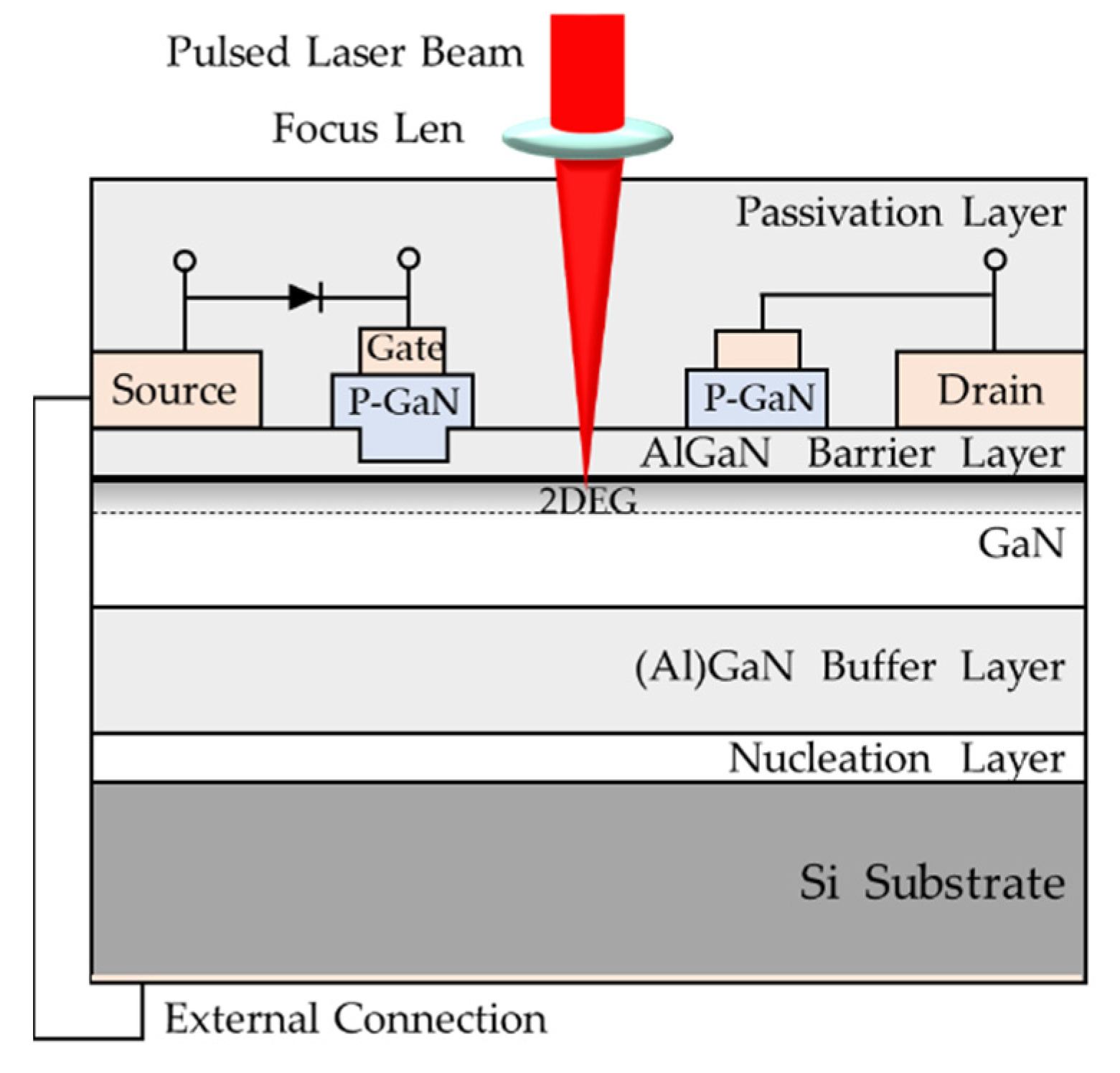
4. Experimental Results and Discussion
4.1. Pulsed Laser Test
4.2. SEM Verification
4.3. SEB Mechanism Analysis
5. Conclusions
Author Contributions
Funding
Institutional Review Board Statement
Informed Consent Statement
Data Availability Statement
Conflicts of Interest
References
- Kuboyama, S.; Matsuda, S.; Kanno, T.; Hirose, T. Single event burnout of power MOSFETs caused by nuclear reactions with heavy ions. IEEE Trans. Nucl. Sci. 1994, 41, 2210–2215. [Google Scholar] [CrossRef]
- Martinez, M.J.; King, M.P.; Baca, A.G.; Allerman, A.A.; Armstrong, A.A.; Klein, B.A.; Douglas, E.A.; Kaplar, R.J.; Swanson, S.E. Radiation response of AlGaN-channel HEMTs. IEEE Trans. Nucl. Sci. 2018, 66, 344–351. [Google Scholar] [CrossRef]
- McPherson, J.A.; Kowal, P.J.; Pandey, G.K.; Chow, T.P.; Ji, W.; Woodworth, A.A. Heavy ion transport modeling for single-event burnout in SiC-based power devices. IEEE Trans. Nucl. Sci. 2018, 66, 474–481. [Google Scholar] [CrossRef]
- Cardoza, D.M.; LaLumondiere, S.D.; Tockstein, M.A.; Witczak, S.C.; Sin, Y.; Foran, B.J.; Lotshaw, W.T.; Moss, S.C. Single event transients induced by picosecond pulsed X-ray absorption in III–V heterojunction transistors. IEEE Trans. Nucl. Sci. 2012, 59, 2729–2738. [Google Scholar] [CrossRef]
- Shu, L.; Qi, C.H.; Galloway, K.F.; Zhao, Y.F.; Cao, W.Y.; Li, X.J.; Wang, L.; Zhang, E.X.; Wang, X.S.; Shi, R.X.; et al. Observation of single event burnout (SEB) in an SOI NLDMOSFET using a pulsed laser. Microelectron. Reliab. 2021, 116, 113997. [Google Scholar] [CrossRef]
- Luu, A.; Miller, F.; Poirot, P.; Gaillard, R.; Buard, N.; Carriere, T.; Austin, P.; Bafleur, M.; Sarrabayrouse, G. SEB characterization of commercial power MOSFETs with backside laser and heavy ions of different ranges. IEEE Trans. Nucl. Sci. 2008, 55, 2166–2173. [Google Scholar] [CrossRef]
- Darracq, F.; Mbaye, N.; Larue, C.; Pouget, V.; Azzopardi, S.; Lorfevre, E.; Bezerra, F.; Lewis, D. Imaging the single event burnout sensitive volume of vertical power MOSFETs using the laser two-photon absorption technique. In Proceedings of the 12th European Conference on Radiation and Its Effects on Components and Systems, Sevilla, Spain, 19–23 September 2011. [Google Scholar]
- Shangguan, S.; Ma, Y.; Han, J.; Cui, Y.; Wang, Y.; Chen, R.; Liang, Y.; Zhu, X.; Li, Y. Single event effects of SiC diode demonstrated by pulsed-laser two photon absorption. Microelectron. Reliab. 2021, 125, 114364. [Google Scholar] [CrossRef]
- Johnson, R.A.; Witulski, A.F.; Ball, D.R.; Galloway, K.F.; Sternberg, A.L.; Zhang, E.; Ryder, L.D.; Reed, R.A.; Schrimpf, R.D.; Kozub, J.A.; et al. Enhanced charge collection in SiC power MOSFETs demonstrated by pulse-laser two-photon absorption SEE experiments. IEEE Trans. Nucl. Sci. 2019, 66, 1694–1701. [Google Scholar] [CrossRef]
- Millan, J.; Godignon, P.; Perpiñà, X.; Pérez-Tomás, A.; Rebollo, J. A survey of wide bandgap power semiconductor devices. IEEE Trans. Power Electron. 2013, 29, 2155–2163. [Google Scholar] [CrossRef]
- Singh, S.; Shrivastav, A.; Bhattacharya, S. Gan fet based cubesat electrical power system. In Proceedings of the 2015 IEEE Applied Power Electronics Conference and Exposition, Charlotte, NC, USA, 15–19 March 2015. [Google Scholar]
- Abbate, C.; Busatto, G.; Iannuzzo, F.; Mattiazzo, S.; Sanseverino, A.; Silvestrin, L.; Tedesco, D.; Velardi, F. Experimental study of Single Event Effects induced by heavy ion irradiation in enhancement mode GaN power HEMT. Microelectron. Reliab. 2015, 55, 1496–1500. [Google Scholar] [CrossRef]
- Kuboyama, S.; Maru, A.; Shindou, H.; Ikeda, N.; Hirao, T.; Abe, H.; Tamura, T. Single-event damages caused by heavy ions observed in AlGaN/GaN HEMTs. IEEE Trans. Nucl. Sci. 2011, 58, 2734–2738. [Google Scholar] [CrossRef]
- Mizuta, E.; Kuboyama, S.; Nakada, Y.; Takeyama, A.; Ohshima, T.; Iwata, Y.; Suzuki, K. Single-event damage observed in GaN-on-Si HEMTs for power control applications. IEEE Trans. Nucl. Sci. 2018, 65, 1956–1963. [Google Scholar] [CrossRef]
- Zerarka, M.; Crepel, O. Radiation robustness of normally-off GaN/HEMT power transistors (COTS). Microelectron. Reliab. 2018, 88, 984–991. [Google Scholar] [CrossRef]
- Khachatrian, A.; Roche, N.J.H.; Buchner, S.; Koehler, A.D.; Anderson, T.J.; Ferlet-Cavrois, V.; Muschitiello, M.; McMorrow, D.; Weaver, B.; Hobart, K.D. A comparison of Single-Event Transients in Pristine and Irradiated Al0.3Ga0.7N/GaN HEMTs using Two-Photo Absorption and Heavy Ions. IEEE Trans. Nucl. Sci. 2015, 62, 2743–2751. [Google Scholar] [CrossRef]
- Roche, N.J.; Khachatrian, A.; King, M.; Buchner, S.P.; Halles, J.; Kaplar, R.; Armstrong, A.; Kizilyalli, I.C.; Cunningham, P.D.; Melinger, J.S.; et al. Two-photon absorption pulsed-laser single-event effect technique for GaN materials and the impact of deep level traps on the carrier generation process. In Proceedings of the 16th European Conference on Radiation and Its Effects on Components and Systems, Bremen, Germany, 19–23 September 2016. [Google Scholar]
- Ngom, C.; Pouget, V.; Zerarka, M.; Coccetti, F.; Touboul, A.; Matmat, M.; Crepel, O.; Bascoul, G. Backside Laser Testing of Single-Event Effects in GaN-on-Si Power HEMTs. IEEE Trans. Nucl. Sci. 2021, 68, 1642–1650. [Google Scholar] [CrossRef]
- Ngom, C.; Pouget, V.; Zerarka, M.; Coccetti, F.; Crepel, O.; Touboul, A.; Matmat, M. Modelling of charge injection by multi-photon absorption in GaN-on-Si HEMTs for SEE testing. Microelectron. Reliab. 2021, 126, 114339. [Google Scholar] [CrossRef]
- Tanaka, K.; Morita, T.; Umeda, H.; Kaneko, S.; Kuroda, M.; Ikoshi, A.; Yamagiwa, H.; Okita, H.; Hikita, M.; Yanagihara, M.; et al. Suppression of current collapse by hole injection from drain in a normally-off GaN-based hybrid-drain-embedded gate injection transistor. Appl. Phys. Lett. 2015, 107, 163502. [Google Scholar] [CrossRef]
- Floriduz, A.; Devine, J.D. High-energy proton irradiation effects on GaN hybrid-drain-embedded gate injection transistors. Microelectron. Reliab. 2020, 110, 113656. [Google Scholar] [CrossRef]
- Polyanskiy, M. Refractive Index Database. Available online: https://refractiveindex.info/ (accessed on 5 March 2022).
- Muth, J.F.; Brown, J.D.; Johnson, M.A.L.; Yu, Z.; Kolbas, R.M.; Cook, J.W.; Schetzina, J.F. Absorption coefficient and refractive index of GaN, AlN and AlGaN alloys. Mater. Res. Soc. Internet J. Nitride Semicond. Res. 1999, 4, 502–507. [Google Scholar] [CrossRef] [Green Version]
- Zhang, R.; Kozak, J.P.; Xiao, M.; Liu, J.; Zhang, Y. Surge-energy and overvoltage ruggedness of P-gate GaN HEMTs. IEEE Trans. Power Electron. 2020, 35, 13409–13419. [Google Scholar] [CrossRef]
- Kizilyalli, I.C.; Edwards, A.P.; Nie, H.; Disney, D.; Bour, D. High voltage vertical GaN pn diodes with avalanche capability. IEEE Trans. Electron. Devices 2013, 60, 3067–3070. [Google Scholar] [CrossRef]
- Saito, W.; Kuraguchi, M.; Takada, Y.; Tsuda, K.; Omura, I.; Ogura, T. Influence of surface defect charge at AlGaN-GaN-HEMT upon Schottky gate leakage current and breakdown voltage. IEEE Trans. Electron. Devices 2005, 52, 159–164. [Google Scholar] [CrossRef]
- Meneghesso, G.; Meneghini, M.; Bisi, D.; Rossetto, I.; Wu, T.L.; Van Hove, M.; Marcon, D.; Stoffels, S.; Decoutere, S.; Zanoni, E. Trapping and reliability issues in GaN-based MIS HEMTs with partially recessed gate. Microelectron. Reliab. 2016, 58, 151–157. [Google Scholar] [CrossRef]

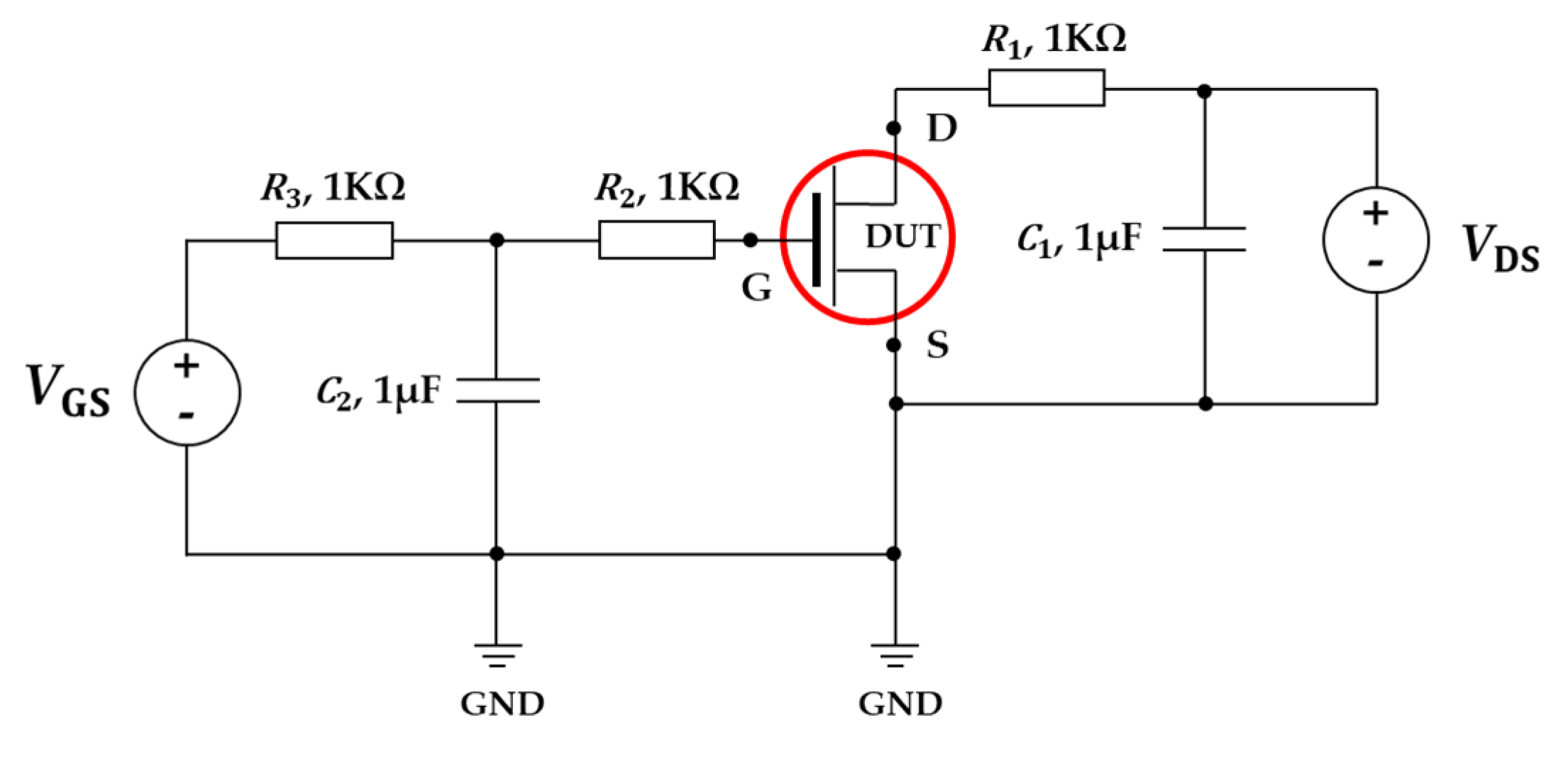
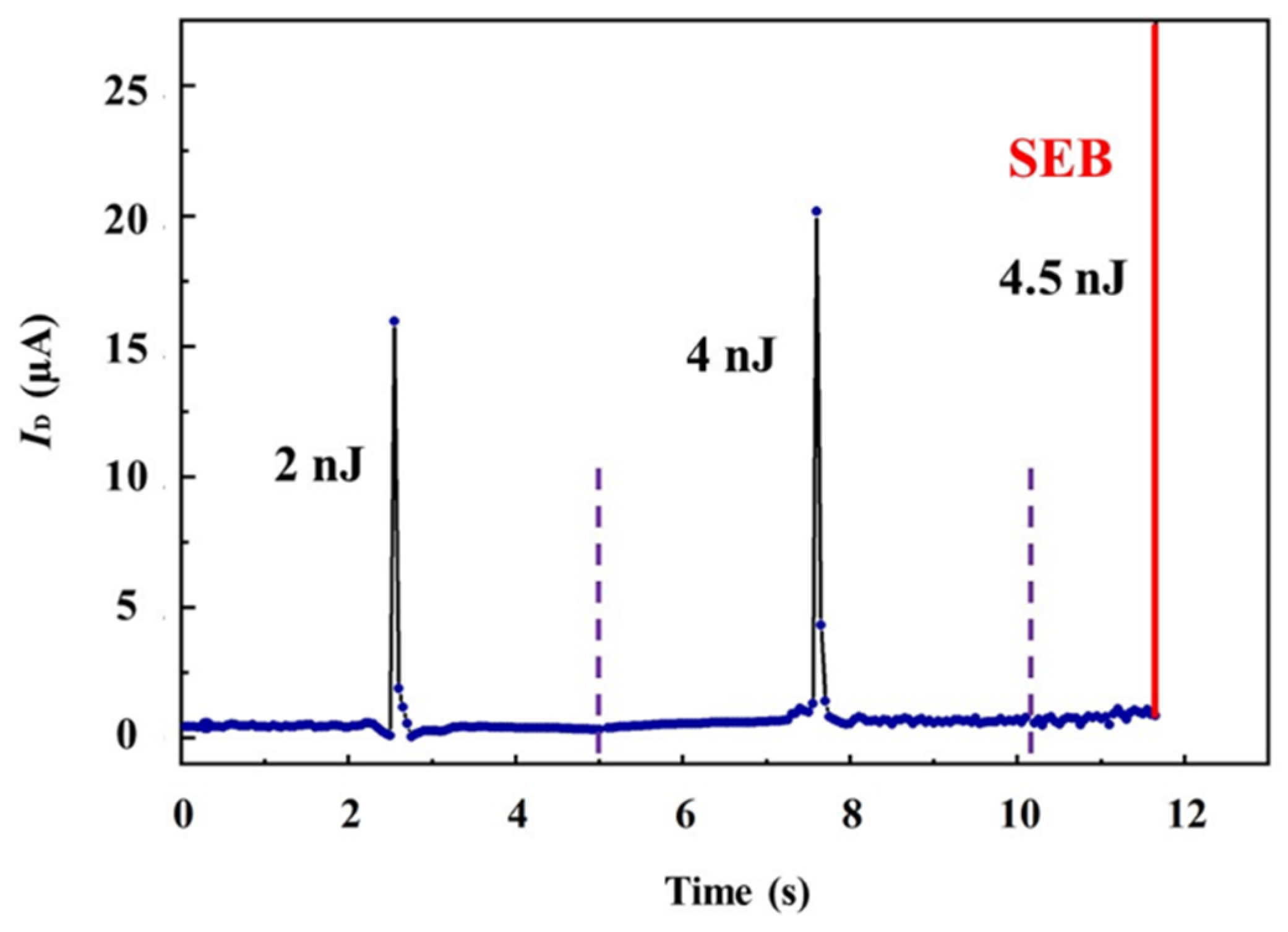
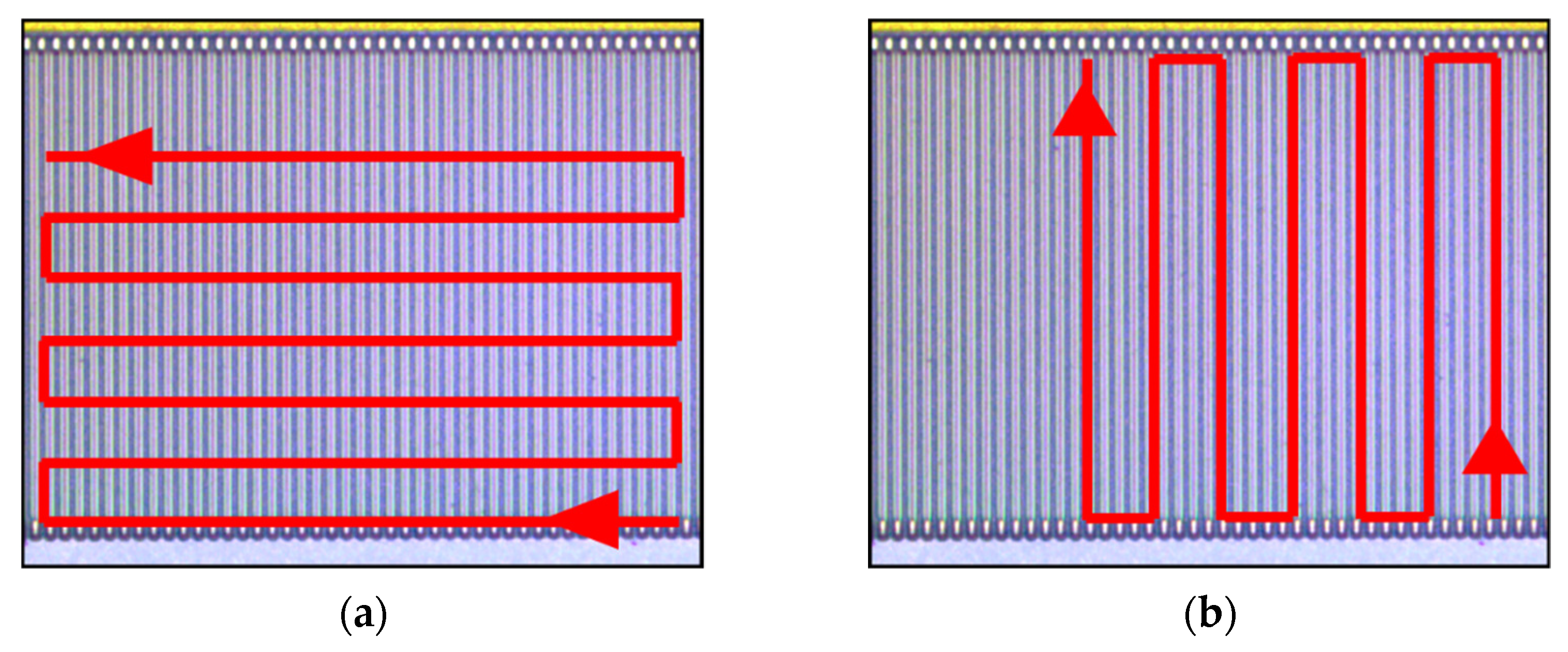
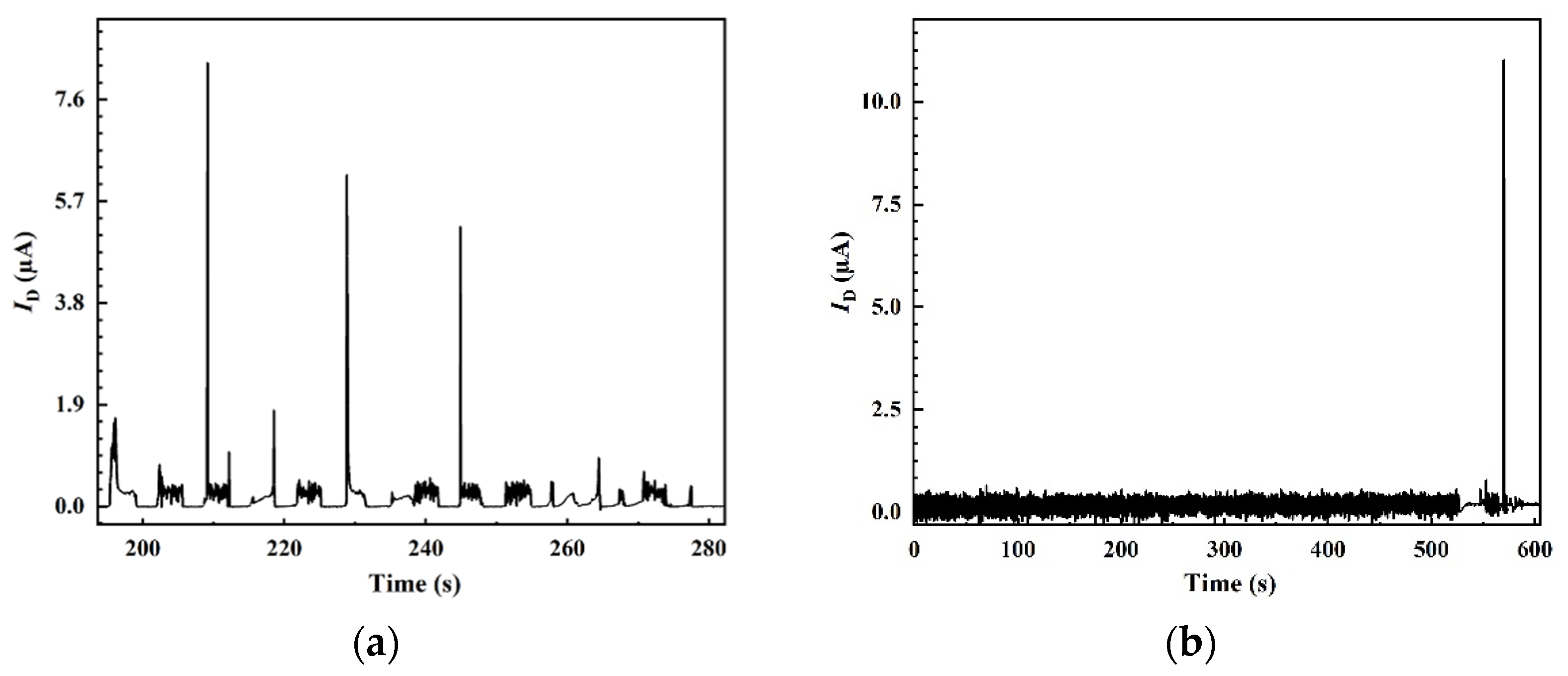
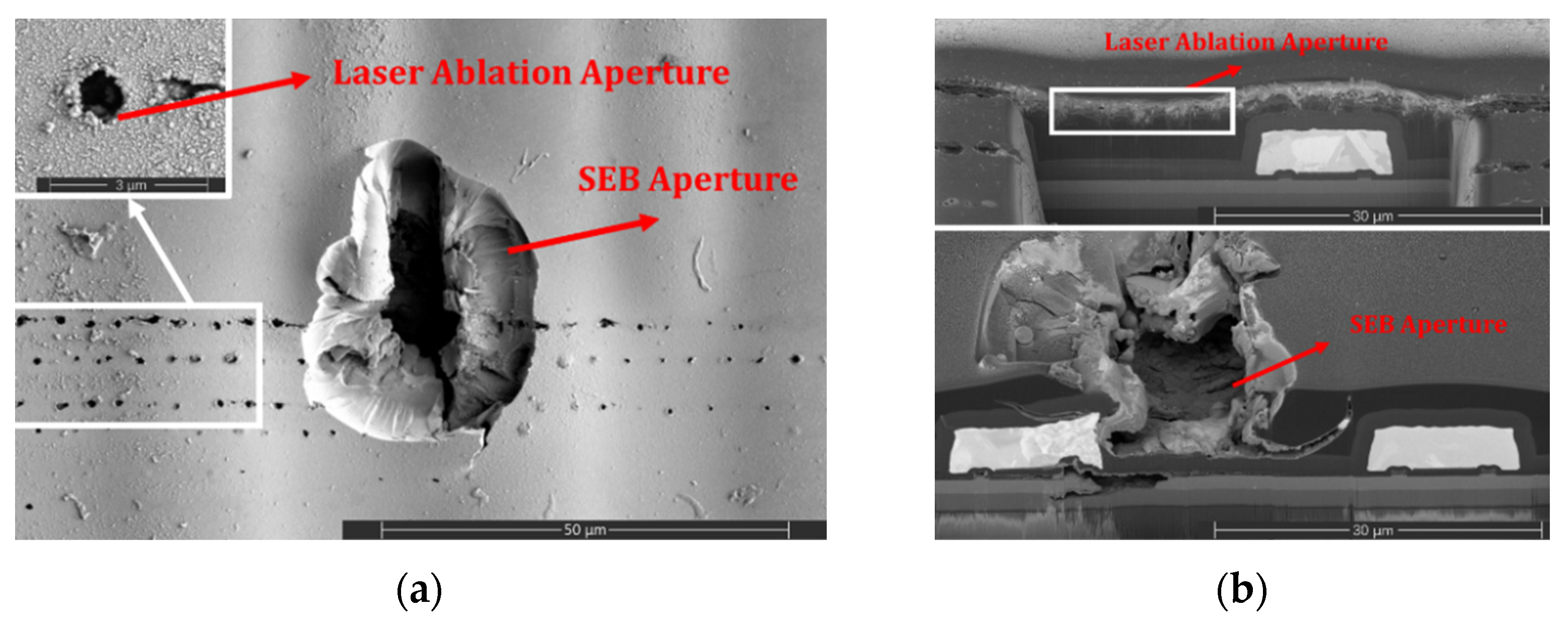

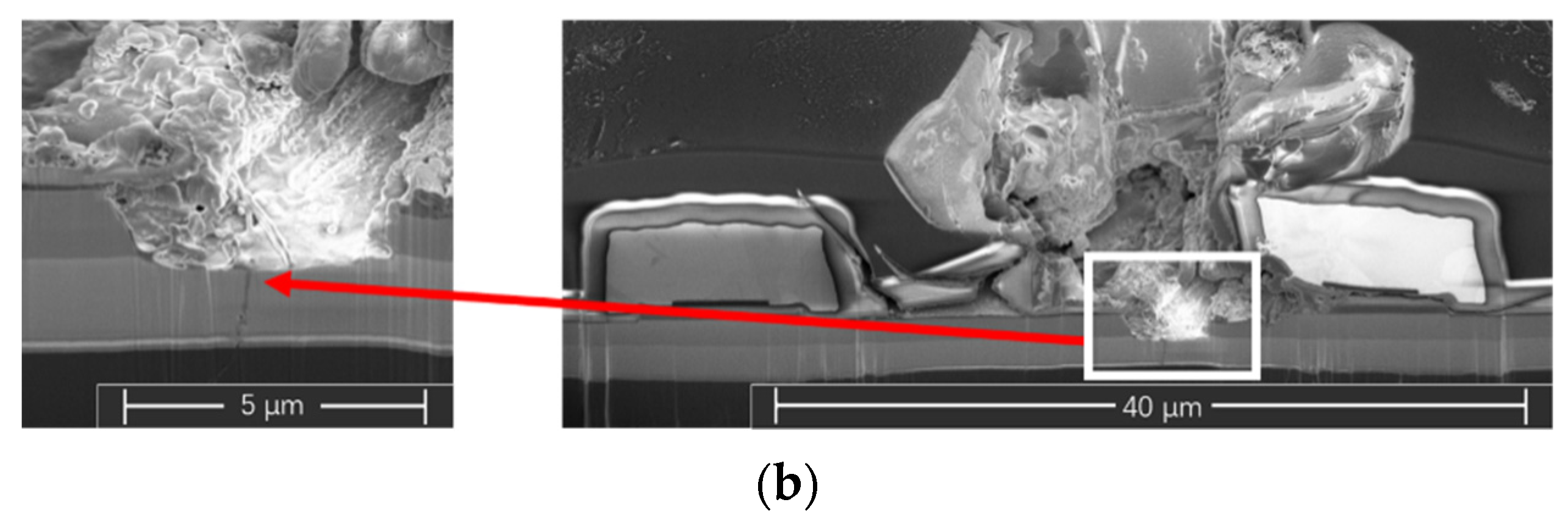


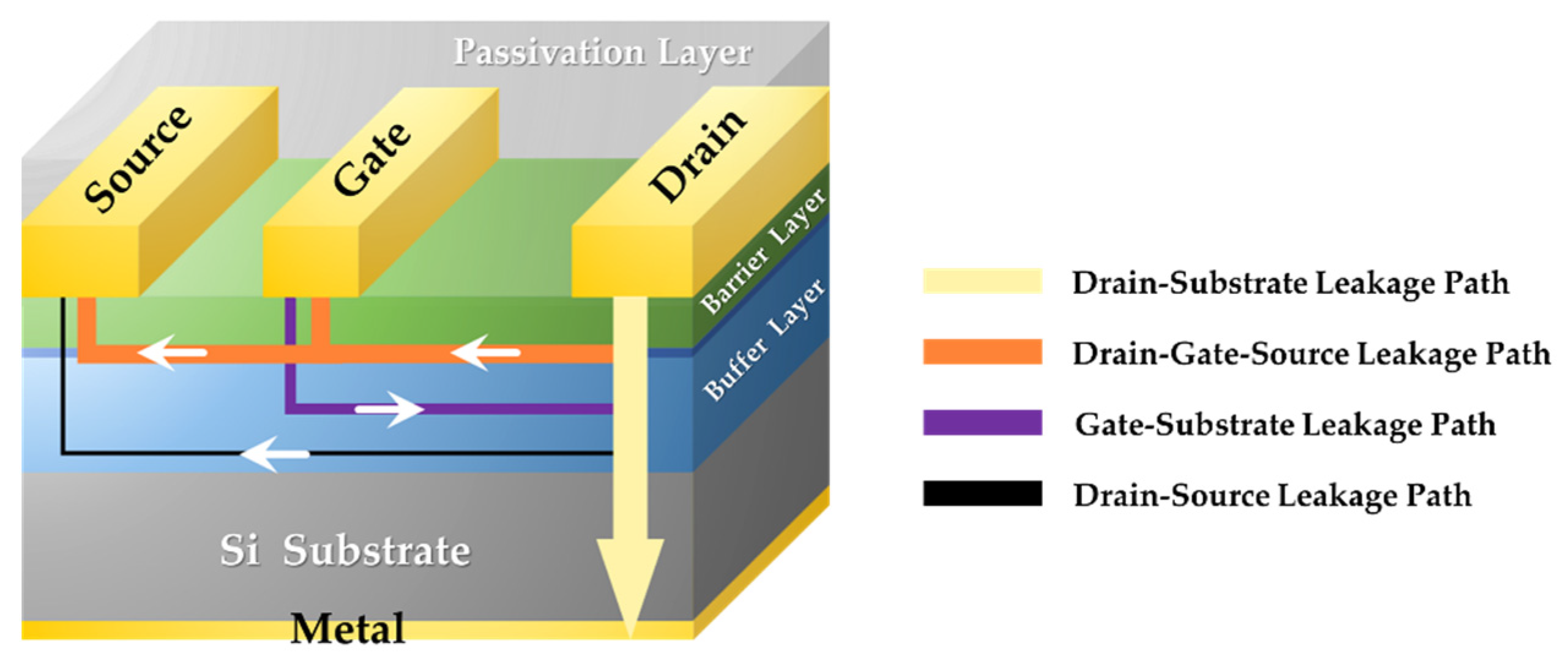
Publisher’s Note: MDPI stays neutral with regard to jurisdictional claims in published maps and institutional affiliations. |
© 2022 by the authors. Licensee MDPI, Basel, Switzerland. This article is an open access article distributed under the terms and conditions of the Creative Commons Attribution (CC BY) license (https://creativecommons.org/licenses/by/4.0/).
Share and Cite
Cui, Y.; Ma, Y.; Shangguan, S.; Han, J. Study of Single Event Burnout Mechanism in GaN Power Devices Using Femtosecond Pulsed Laser. Photonics 2022, 9, 270. https://doi.org/10.3390/photonics9040270
Cui Y, Ma Y, Shangguan S, Han J. Study of Single Event Burnout Mechanism in GaN Power Devices Using Femtosecond Pulsed Laser. Photonics. 2022; 9(4):270. https://doi.org/10.3390/photonics9040270
Chicago/Turabian StyleCui, Yixin, Yingqi Ma, Shipeng Shangguan, and Jianwei Han. 2022. "Study of Single Event Burnout Mechanism in GaN Power Devices Using Femtosecond Pulsed Laser" Photonics 9, no. 4: 270. https://doi.org/10.3390/photonics9040270
APA StyleCui, Y., Ma, Y., Shangguan, S., & Han, J. (2022). Study of Single Event Burnout Mechanism in GaN Power Devices Using Femtosecond Pulsed Laser. Photonics, 9(4), 270. https://doi.org/10.3390/photonics9040270



